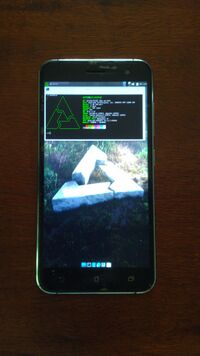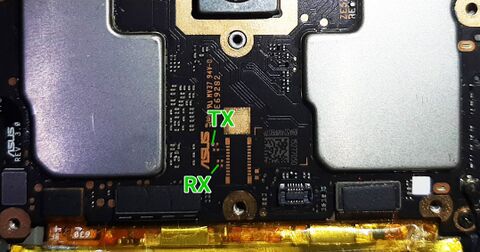Asus Zenfone 3 (asus-zenfone3)
 Asus Zenfone 3 | |
| Manufacturer | Asus |
|---|---|
| Name | Zenfone 3 |
| Codename | asus-zenfone3 |
| Released | 2016 |
| Type | handset |
| Hardware | |
| Chipset | Qualcomm Snapdragon 625 (MSM8953) |
| CPU | Octa-core 2.0 GHz Cortex-A53 |
| GPU | Adreno 506 |
| Display | 1080x1920 IPS LCD |
| Storage | 32 GB / 64 GB |
| Memory | 3 GB / 4 GB |
| Architecture | aarch64 |
| Software | |
Original software The software and version the device was shipped with. |
Android 6.0.1 |
Extended version The most recent supported version from the manufacturer. |
Android 8.0.0 |
| postmarketOS | |
| Category | testing |
Mainline Instead of a Linux kernel fork, it is possible to run (Close to) Mainline. |
yes |
| Device package |
|
| Kernel package |
|
Flashing Whether it is possible to flash the device with pmbootstrap flasher. |
Works
|
|---|---|
USB Networking After connecting the device with USB to your PC, you can connect to it via telnet (initramfs) or SSH (booted system). |
Works
|
Internal storage eMMC, SD cards, UFS... |
Works
|
SD card Also includes other external storage cards. |
Works
|
Battery Whether charging and battery level reporting work. |
Works
|
Screen Whether the display works; ideally with sleep mode and brightness control. |
Works
|
Touchscreen |
Works
|
| Multimedia | |
3D Acceleration |
Works
|
Audio Audio playback, microphone, headset and buttons. |
Works
|
Camera |
Broken
|
Camera Flash |
Broken
|
| Connectivity | |
WiFi |
Works
|
Bluetooth |
Works
|
GPS |
Works
|
| Modem | |
Calls |
Partial
|
SMS |
Works
|
Mobile data |
Works
|
| Miscellaneous | |
FDE Full disk encryption and unlocking with unl0kr. |
Broken
|
USB OTG USB On-The-Go or USB-C Role switching. |
Broken
|
| Sensors | |
Accelerometer Handles automatic screen rotation in many interfaces. |
Works
|
Magnetometer Sensor to measure the Earth's magnetism |
Works
|
Ambient Light Measures the light level; used for automatic screen dimming in many interfaces. |
Works
|
Proximity |
Works
|
Haptics |
Broken
|
There are two variants of the Zenfone 3, the ZE520KL and the ZE552KL, differing only in screen panels, batteries, and possibly some sensors unique to each variant. At the time of writing, only the ZE520KL has been tested, but the ZE552KL should also be able to boot mainline without major issues.
Contributors
- User:Smankusors
- Uefa41
Users owning this device
- Briskly6379 (Notes: Running pmOS/PlasmaMobile)
- Smankusors (Notes: The ZE520KL variant)
- Tjari (Notes: ZE520KL; ghost touch)
How to enter flash mode
- Stock Fastboot: Press and hold + together while device is turned off.
- lk2nd Fastboot: Turn on the device. When it vibrates, press and hold .
Installation
Unlock bootloader
Since Asus has shut down its unlock service, there’s no official way to unlock the Zenfone 3. However, an unofficial method exists:
- Flash factory RAW
- Execute
fastboot oem unlock - Execute
fastboot reboot bootloader - Flash Oreo RAW to restore Android
lk2nd Installation
Please make sure you have the boot.img from your current Android ROM, so that you can boot back into Android.
(A TWRP backup image might not work, since it would be too large to fit into the boot partition. Please use the original image instead of backup)
- Download lk2nd-msm8953.img from https://github.com/msm8916-mainline/lk2nd/releases
- Put the device to fastboot mode
fastboot flash boot lk2nd-msm8953.img- Done!
To boot Android back,
- Wait until lk2nd screen appears
fastboot flash boot boot.imgfastboot reboot
Now Android should boot like normal.
For more information about lk2nd, you can read lk2nd/lk1st.
postmarketOS Installation
Make sure you flashed the lk2nd first!
This guide explains how to install postmarketOS on an SD card. I recommend using Linux for this, although Termux on another rooted phone might also work.
- Install pmbootstrap
pmbootstrap init- Follow the instructions, make sure you choose Vendor = Asus, and Device codename = zenfone3
pmbootstrap install --sdcard=[your sdcard location]- Insert the sdcard to the phone, reboot, and you should now boot into postmarketOS now.
For more information about pmbootstrap, you can read pmbootstrap
Current issues
- Camera doesn't work yet
- Haptics/vibration doesn't work yet (missing driver support, probably will be supported from 6.12)
- No laser distance sensor yet
- No front LED control yet
- No fingerprint
- Buttons on headphone jack mapped incorrectly (need confirmation)
- Calls have a sound problem somehow, haven't dig deeper on this yet
- We have Venus video decode support on mainline kernel, but somehow there's a bottleneck somewhere on the players
- Battery will not charge to 100%
- Touchkeys is not working yet, it's missing support on
edt-ft5x06driver - Several sensors are not enabled yet (smankusors: I'm currently checking on this)
Serial UART
To obtain bootloader logs on the ZE520KL variant, follow the test points shown in the image below. Note that the UART operates at 1.8V. For kernel version 3.18 (downstream Android kernel), set the console to ttyHSL0. For kernel version 4.9 and later, including mainline kernels, set the console to ttyMSM0.
For more information about serial debugging, please read Serial debugging.
See also
- pmaports!3731 Initial merge request (abandoned by Uefa41?)
- pmaports!5711 Second merge request
- Kernel source
 device-asus-zenfone3
device-asus-zenfone3 firmware-asus-zenfone3
firmware-asus-zenfone3- LineageOS wiki
